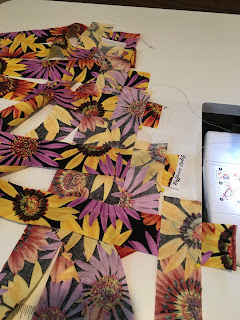I picked the larger of the spray basted quilts to work on today!
Originally I was going to do curves in the binding. Gentle curves with equal measurements on the top and bottom... But then when trying to figure where they would start and end I noticed the design of the quilt was asymmetrical, something that had appealed to me when I picked the pattern. But something that I had to think about toward the end when I was adding the final borders. I decided then to have the borders be equal on all sides, and that is what I decided about the binding too.
So I practiced another magic binding finish!
Changes and tips I used again:
Stitched the edges of the quilt together before trimming.
Trimmed so the back and batting were approx .25 inch wider than the top. (I then trimmed the backing so it was closer to the top position, but realized after that I should have kept the fabric and instead concentrated on placing the edge of the binding so it was on the stay stitching line. Photos below.)
Did the trick of pressing the ends to help me keep track of which side to put where on the plain black fabric. (no photo)
Pinned and then sewed each joining set all at one time.
Cut the flange 2 inches (instead of 1.75) so more of it would show.
Cut the main color still 1.5 inch and used fabric recovered after trimming the backing and batting so it was a tad sticky. I did not press the seams open for the fabric joins of each strip as I wasn't sure what would happen to the iron or fabric.
Sewed and pressed the combined pieces oriented it so I could see the flange. I did press the seam open for the two fabric strips and I pressed the color on top of the black color to get rid of the sticky side being exposed. Worked well.
Here I show sewing the binding on. It would have been easier if I had not cut the backing back - the batting kept getting caught on the presser foot.
I lined up the edge of the binding with the stay stitching line.
I used the tip of pinching the end at the corner then bringing the result up to meet the sewing line. And I used the stack of fabric (I didn't have emery board handy) so the pressure foot at the corners was level with the fold when I was sewing that to the back.
When I got to the end, I folded the binding back after having it meet.
Then I pressed the fold, and used a pencil to mark the intersection line.
I referred to the photos from last night to help me orient the fabric and so got it right the first time!
The final binding stitching didn't take very long. I prepared each corner with Wonder Clips and oriented it so I could just continue sewing with little effort.
More of the flange shows, which in this case with plain fabric, I like. I'm still getting an extra line of stitching that shows on the back, but the binding is done and this charity quilt is now ready for free motion quilting!
As I was working on the binding I started thinking ahead to the buckets of grapefruit waiting to be turned into marmalade. My son and I keep charts of what we do (amounts of fruit, water, sugar; cooking times and temperature). Seems we are always tweaking something, just like I was tweaking the making and application of this binding.











I really like the way the binding looks, with the solid, dark flange and the outer binding matching the border. Very striking!
ReplyDeleteThank you so much!
Delete